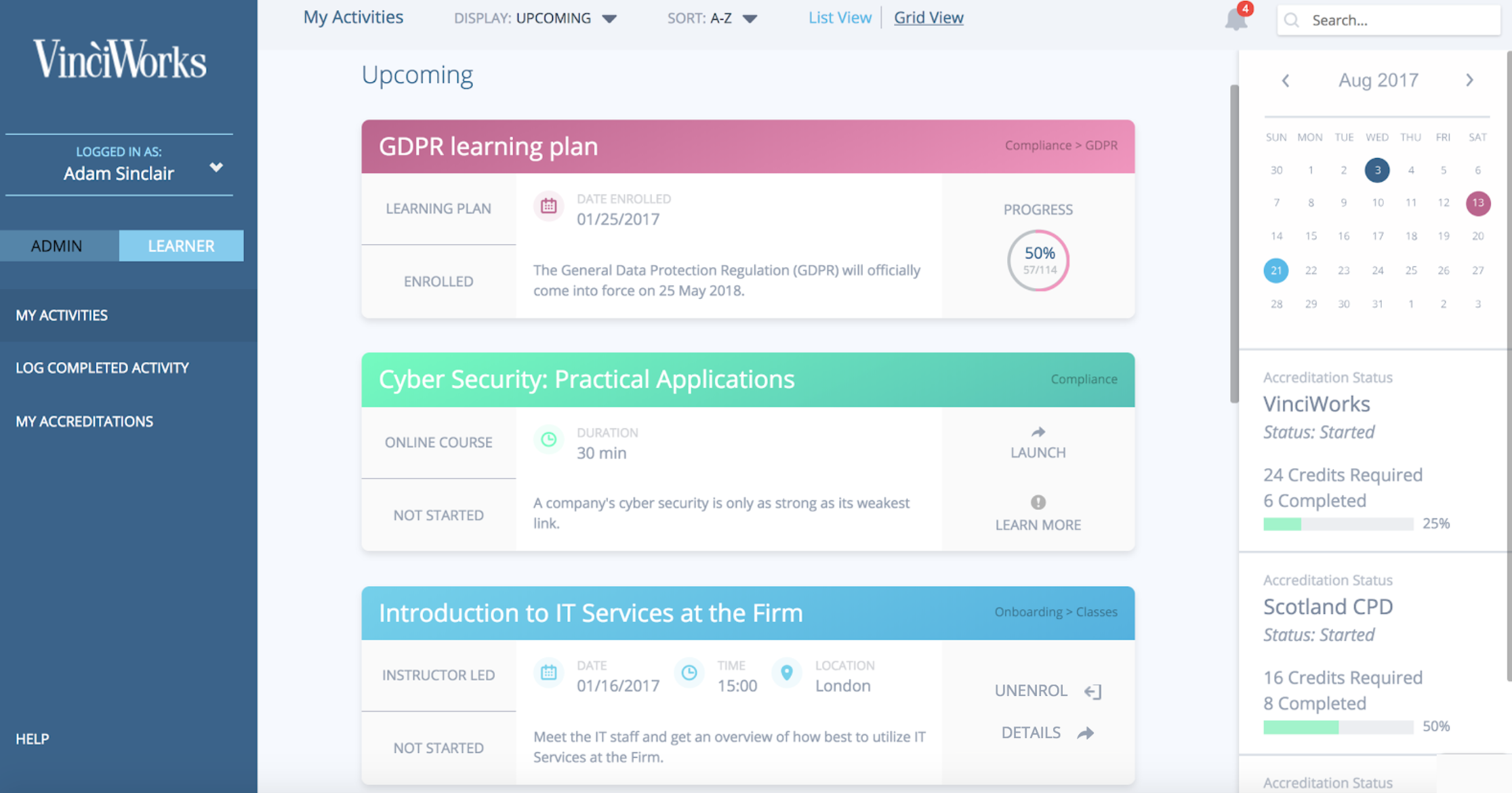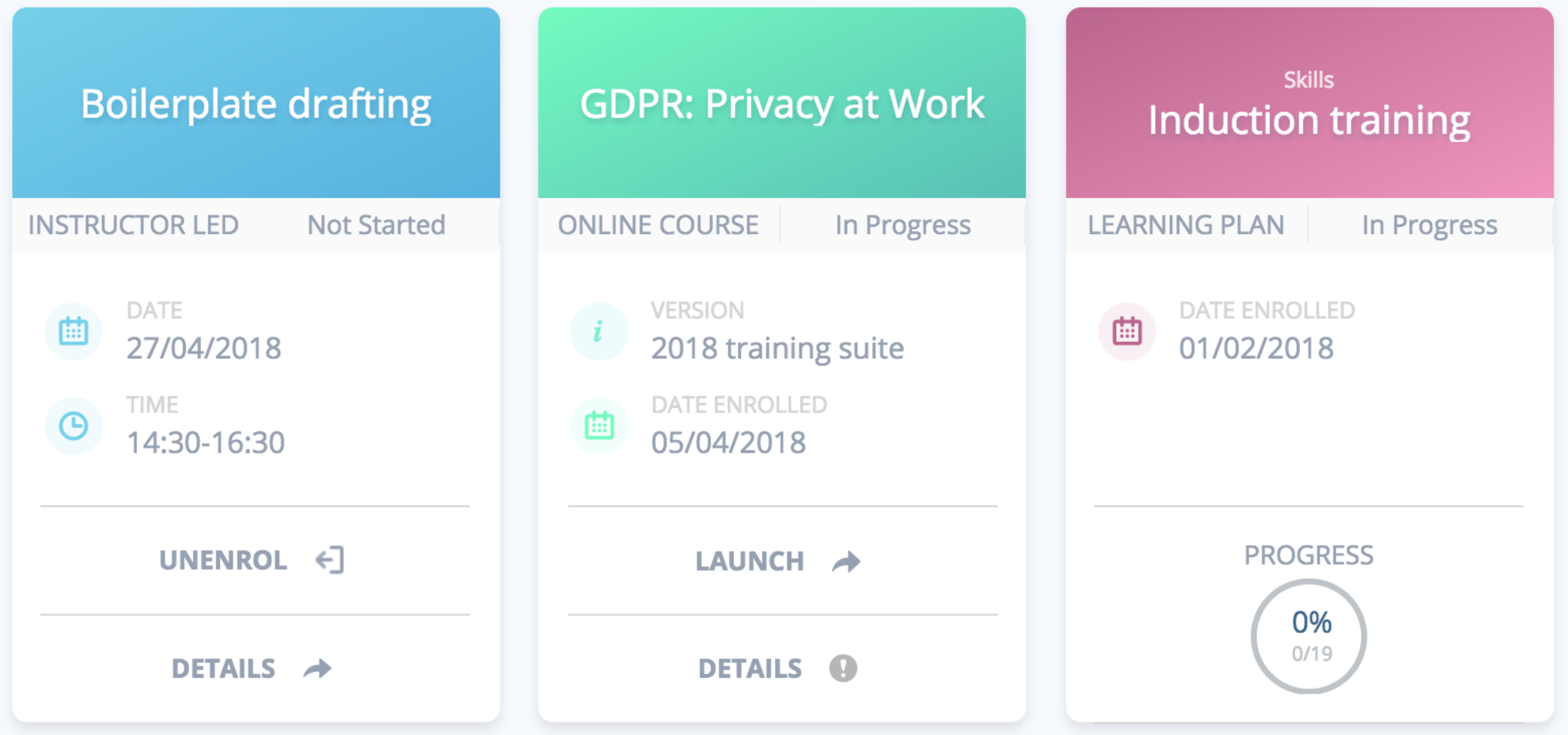
What is a learning management system (LMS)? Who needs an LMS? How do they help with learning? While many have heard the term, for others it may be difficult to understand exactly what an LMS is and how it could be helpful to your organisation. Here is everything you need to know.
What is a Learning Management System?
The best way to describe a learning management system is to break down the title.
Learning – organisations manage ranges of staff, from a small team of ten to a multitude of departments, amounting to thousands of employees. Those employees are assigned to train on a number of topics, ranging from compliance training such as anti-money laundering, to webinars, workshops and seminars.
Management – an LMS makes managing the hours of learning assigned to individual staff members far easier to monitor and track and, well, more manageable. A powerful LMS will offer strong automation features to keep track of users and easily follow up on task completion.
System – There is only so much an excel spreadsheet can do. All the functionalities that come along with managing learning for a team from adding users and email templates to reminding and reporting are an important aspect of easing the burden on administrators, making completing learning tasks easier for users. In short, an LMS is a system that assists staff in completing learning activities and administrators in managing their staff’s learning.
Who uses an LMS?
Most organisations who roll out e-learning training use an LMS. This can include large financial institutions, universities or law firms, as well as small practices with under ten employees. While smaller organisations may not necessarily require a fully robust system, one will surely help large and small companies alike stay on top of their employees’ learning.
What is the purpose of a learning management system
A strong LMS will have a wide range of features available, yet no two companies are the same. This means every organisation will have best uses for their LMS. Here are the main reasons organisations invest in an LMS:
Onboarding new employees
When new employees start their job, it can often be quite overwhelming for employees and managers alike to try and impart a lot of knowledge to them in a short period of time. Being able to easily set and enrol new staff on short activities such as e-learning courses or workshops can aid in getting them up to speed with the inner-workings of the business. Once the staff have been asked to complete their learning, such as reviewing the company mission statement, policies and codes of conduct, an LMS can offer automated reminders, functionality that will further streamline the process.
Compliance training
Keeping on top of employees’ compliance training is made easy with an LMS. Not all staff require the same training. With modern slavery training, for example, procurement staff will require specialised training while lower-risk staff will need a general overview of their responsibilities under the Modern Slavery Act. The automation that an LMS provides ensures the right course gets delivered to the right user.
Refresher training
Similarly to onboarding, many organisations require their staff to refresh their compliance training topics each year. While this may include taking the same training each year, we encourage staff to take short knowledge checks to review their understanding of a particular topic. An LMS can help automate the process of enroling staff in all their refresher training from their first day at work.
Planning offline learning activities
While LMSs are primarily used for e-learning training, they also allow administrators to enrol users in any in-person activity, from workshops and meetings to teamwork-building outings. Similarly to arranging online training, administrators can assign staff members to offline activities, which includes the option of having the activity automatically added to their calendars.
How does a learning management system work
An LMS serves as an online platform that allows teachers or administrators to create, deliver, and manage eLearning content. It is a one-stop system for managing learning, compliance, online courses and policies at your organisation, including across multiple industries and jurisdictions.
Getting the most out of your LMS

LMSs provide a range of features that automate learning management and ensuring the plan you choose covers your organisation’s needs is important.
Here are some features included in the VinciWorks LMS:
- Customise everything, including company logo and colours
- Learning plans that can be nested within other learning plans, where courses can be linked directly with deep links
- “Learning cards”, providing users with all their learning details at a glance
- Smart groups to automatically enrol people in appropriate courses
- Customisable emails and certificates
- Nagware software, allowing administrators to automatically remind users to complete their learning activity, inform them their deadline has passed, or warn them how important it is to complete their activities
VinciWorks will soon be releasing a new upgrade of their learning management system, LMS 6.0. To request a free demo, simply complete the form below and someone from our team will contact you.
FAQs about learning management systems
How many learning management systems are there
As of 2022 there are more than 800 options of different LMS platforms, including both open source and proprietary options, with each offering numerous different features. There are pros and cons to each one and it’s a good idea to do research into which one is best for your needs, taking into account the features, price, integrations, and scalability of each one.
How much do learning management systems cost
There’s a wide range of pricing models for LMS systems depending on the needs of the customer. Many LMS vendors use a per user, per month pricing model, with tiers providing additional features. Another model is the per learner, per use model, which allows clients to pay for only the parts of the software that they use. Alternatively, the per course model can work well for employees that need special certification for their industry or job function, while the licensing fee model allows companies to purchase a license to install LMS software on-premise.
There are also additional costs to consider such as the cost of implementation, training, support, maintenance and content creation.
There are also open source and free LMS software available, though these might offer limited functionality and may limit the number of users, and installation and customisation can be more complicated, with not all options offering support if something goes wrong.
How to create a learning management system
- Choose a platform
Choose the platform you want to use to create the learning management system, whether it’s a ready made SaaS (Software as a Service) tool, WordPress based, or custom engine made solution. This decision may be based on cost and your comfort with different systems.
- Create content
Create content for your LMS such as courses, schedules, and materials and assign departments and learners to each course. Each course should include a variety of learning models and a testing module.
- Add evaluations
Adding testing modules or surveys and polls will allow you to check the knowledge of users and will allow you to check if the content you’re providing is useful, depending on the scores of the users. Statistical tools will help you track all activities that learners are engaged in, including showing learners’ progress, what courses learners have completed, and how much time was taken to complete them. This information can help you evaluate the effectiveness of your LMS and make changes where necessary to increase learner engagement and remove ineffective courses.
- Make it Mobile Friendly
In today’s digital, mobile world, it’s important to make sure your LMS is mobile friendly so that employees can access courses and materials from any device.
- Test your LMS
Testing products before launching them is an important step that gives you the chance to review the functionality of the product and find and correct any bugs or mistakes.
What are examples of learning management systems
In the last decade and even more so in the past few years there has been a huge increase in the use of eLearning technology, and LMSs are one of the most popular systems used for online learning. There are hundreds of learning management systems available to choose from today and each one offers different features. There are all-in-one platforms that offer admins the ability to build a complete online academy while creating unique, interactive and social learning experiences. Other platforms focus on being learner-centric, for example, using learning-specific Artificial Intelligence (AI) algorithms that help personalize users’ online learning experience. There are also systems whose main selling point is being very user friendly, allowing people with no technical experience to set up and run the system using the easy-to-use tools the system offers. Still others cater best to corporate and customer training by focusing on an innovative solution in content creation, business analytics, program management and enterprise integrations. It’s important to do careful research into the offerings and pros and cons of each system to figure out which one offers the best set of tools for you and your business’ needs.
What does a learning management system do
A learning management system is a software used for creating, delivering, tracking and reporting educational courses and outcomes. They provide administrators and educators with a way to create and deliver content, monitor user participation and assess learners’ performance.
What makes a good learning management system
The best learning management system for your business will depend on your specific needs. But in general, some of the features that are useful in a learning management system are:
- Ease of use: The platform of the LMS should be intuitive and easy to navigate and use.
- Features and functionality: a good LMS should be full of useful features and aligned to meet the specific needs of your organisation.
- Mobile friendly: It’s important for LMSs to have mobile functionality so that users can train anytime, anywhere, on any type of device.
- Reporting: A good LMS software should be able to draw data from across your platforms and general real time reports quickly
- Flexible: the LMS should have options to cater to a variety of learning styles and accessibility needs.
- Integrations: a good LMS will easily integrate with most HR and admin systems to sync data automatically.
- Cost effective: obviously cost is going to be a factor. While the initial cost is important, there are also ongoing costs to consider. Additionally, it’s important to take long term ROI into consideration, and think about such things as whether the LMS will save on admin time, increase staff productivity, or perhaps save on paper and storage costs.
- Regular updates: Choose an LMS provider that is proactive and forward thinking who will be making regular updates to the system to fix any issues and improve functionality.
- Excellent support: It’s important for your software provider to offer excellent customer service and technical support.








